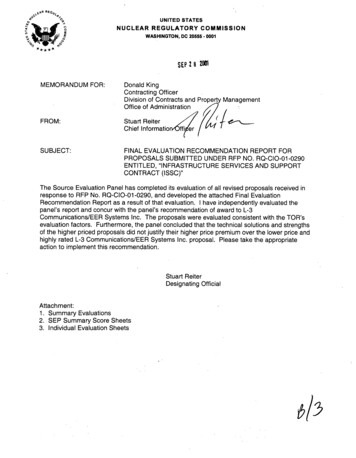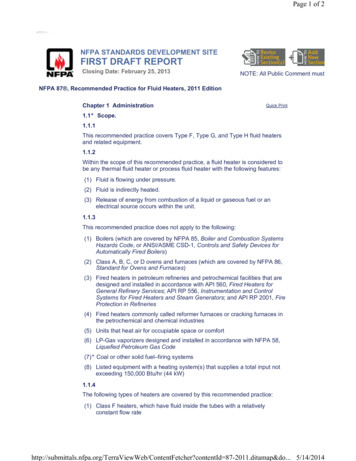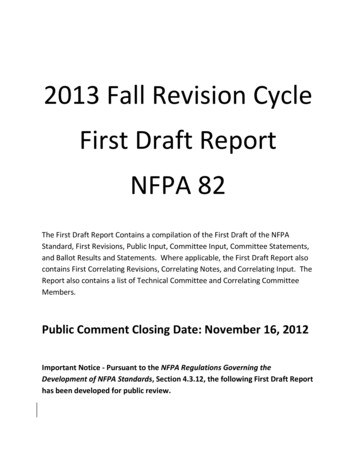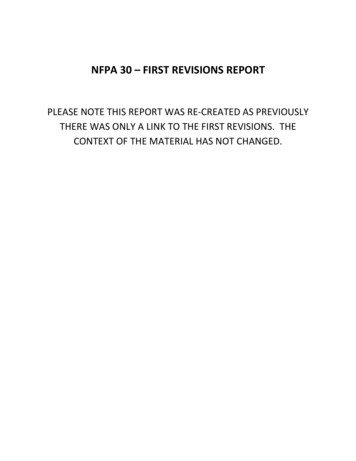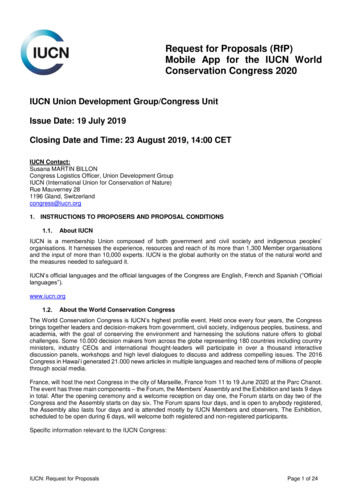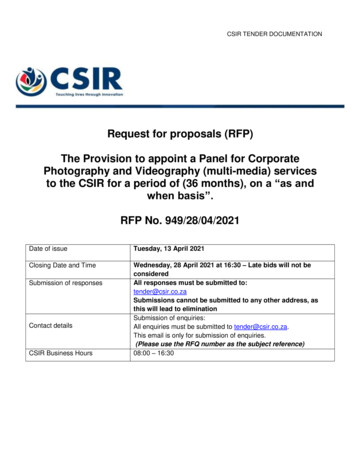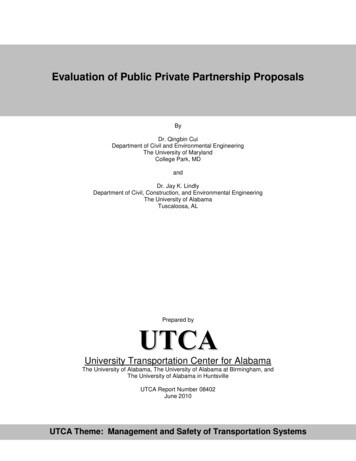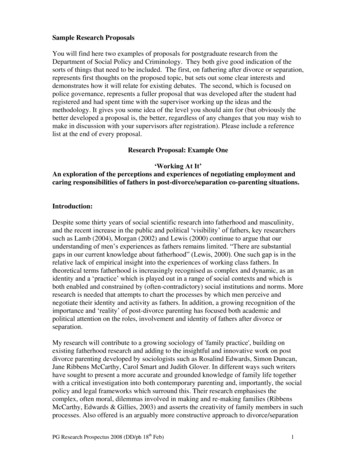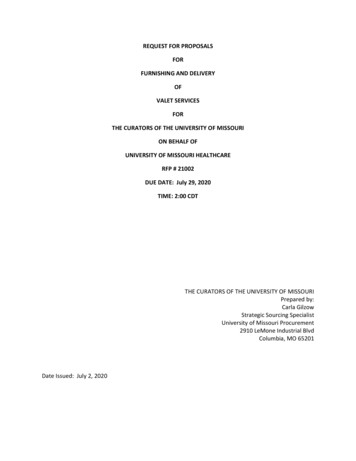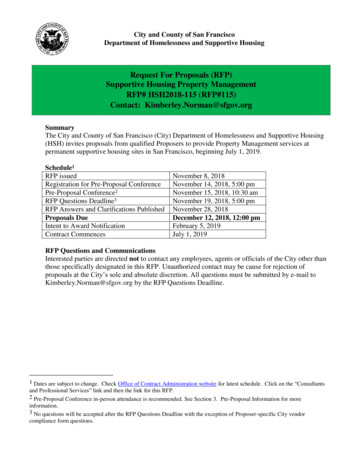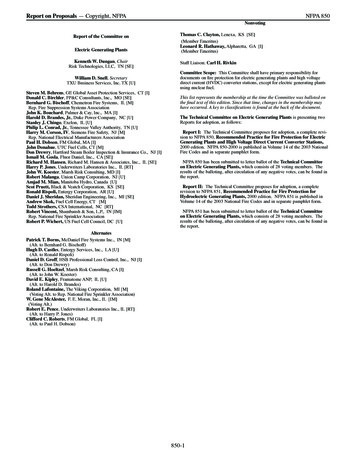
Transcription
Report on Proposals — Copyright, NFPAReport of the Committee onElectric Generating PlantsKenneth W. Dungan, ChairRisk Technologies, LLC, TN [SE]William D. Snell, SecretaryTXU Business Services, Inc. TX [U]Steven M. Behrens, GE Global Asset Protection Services, CT [I]Donald C. Birchler, FP&C Consultants, Inc., MO [SE]Bernhard G. Bischoff, Chemetron Fire Systems, IL [M]Rep. Fire Suppression Systems AssociationJohn K. Bouchard, Palmer & Cay, Inc., MA [I]Harold D. Brandes, Jr., Duke Power Company, NC [U]Stanley J. Chingo, Exelon, IL [U]Philip L. Conrad, Jr., Tennessee Valley Authority, TN [U]Harry M. Corson, IV, Siemens Fire Safety, NJ [M]Rep. National Electrical Manufacturers AssociationPaul H. Dobson, FM Global, MA [I]John Donahue, UTC Fuel Cells, CT [M]Don Drewry, Hartford Steam Boiler Inspection & Insurance Co., NJ [I]Ismail M. Gosla, Fluor Daniel, Inc., CA [SE]Richard M. Hansen, Richard M. Hansen & Associates, Inc., IL [SE]Harry P. Jones, Underwriters Laboratories Inc., IL [RT]John W. Koester, Marsh Risk Consulting, MD [I]Robert Malanga, Union Camp Corporation, NJ [U]Amjad M. Mian, Manitoba Hydro, Canada [U]Scot Pruett, Black & Veatch Corporation, KS [SE]Ronald Rispoli, Entergy Corporation, AR [U]Daniel J. Sheridan, Sheridan Engineering, Inc., MI [SE]Andrew Skok, Fuel Cell Energy, CT [M]Todd Strothers, CSA International, NC [RT]Robert Vincent, Shambaush & Son, L.P., IN [IM]Rep. National Fire Sprinkler AssociationRobert P. Wichert, US Fuel Cell Council, DC [U]NonvotingNFPA 850Thomas C. Clayton, Lenexa, KS [SE](Member Emeritus)Leonard R. Hathaway, Alpharetta, GA [I](Member Emeritus)Staff Liaison: Carl H. RivkinCommittee Scope: This Committee shall have primary responsibility fordocuments on fire protection for electric generating plants and high voltagedirect current (HVDC) converter stations, except for electric generating plantsusing nuclear fuel.This list represents the membership at the time the Committee was balloted onthe final text of this edition. Since that time, changes in the membership mayhave occurred. A key to classifications is found at the back of the document.The Technical Committee on Electric Generating Plants is presenting twoReports for adoption, as follows:Report I: The Technical Committee proposes for adoption, a complete revision to NFPA 850, Recommended Practice for Fire Protection for ElectricGenerating Plants and High Voltage Direct Current Converter Stations,2000 edition. NFPA 850-2000 is published in Volume 14 of the 2003 NationalFire Codes and in separate pamphlet form.NFPA 850 has been submitted to letter ballot of the Technical Committeeon Electric Generating Plants, which consists of 28 voting members. Theresults of the balloting, after circulation of any negative votes, can be found inthe report.Report II: The Technical Committee proposes for adoption, a completerevision to NFPA 851, Recommended Practice for Fire Protection forHydroelectric Generating Plants, 2000 edition. NFPA 851 is published inVolume 14 of the 2003 National Fire Codes and in separate pamphlet form.NFPA 851 has been submitted to letter ballot of the Technical Committeeon Electric Generating Plants, which consists of 28 voting members. Theresults of the balloting, after circulation of any negative votes, can be found inthe report.AlternatesPatrick T. Borns, McDaniel Fire Systems Inc., IN [M](Alt. to Bernhard G. Bischoff)Hugh D. Castles, Entergy Services, Inc., LA [U](Alt. to Ronald Rispoli)Daniel D. Groff, HSB Professional Loss Control, Inc., NJ [I](Alt. to Don Drewry)Russell G. Hoeltzel, Marsh Risk Consulting, CA [I](Alt. to John W. Koester)David E. Kipley, Framatome ANP, IL [U](Alt. to Harold D. Brandes)Roland Lafontaine, The Viking Corporation, MI [M](Voting Alt. to Rep. National Fire Sprinkler Association)W. Gene McAlester, F. E. Moran, Inc., IL [IM](Voting Alt.)Robert E. Pence, Underwriters Laboratories Inc., IL [RT](Alt. to Harry P. Jones)Clifford C. Roberts, FM Global, FL [I](Alt. to Paul H. Dobson)850-1
Report on Proposals — Copyright, NFPANFPA 850NFPA 850does not meet the definition of noncombustible or limited-combustible.Combustible. (secondary) NFPA 850, 2000 ed.Any material that does not comply with the definition of either noncombus850-1 Log #CP1Final Action: Accepttible or limited combustible.( Entire Document (MOS) )Combustible Liquid. (preferred) NFPA 30, 2000 ed.A liquid that has a closed-cup flash point at or above 37.8 C (100 F).Submitter: Technical Committee on Electric Generating PlantsCombustible Liquid. (secondary) NFPA 850, 2000 ed.Recommendation: Completely revise entire document to comply with theA liquid having a flash point at or above 100 F (37.8 C).NFPA Manual of Style as follows:Fire Barrier. (preferred) NFPA 101, 2003 ed.1. Revise Chapter 1 to contain administrative text only as follows:A continuous membrane or a membrane with discontinuities created by pro(show revised text here or indicate where revised text can be found)tected openings with a specified fire protection rating, where such membrane2. Revise Chapter 2 to contain only referenced publications cited in the man- is designed and constructed with a specified fire resistance rating to limit thedatory portions of the document.spread of fire, that also restricts the movement of smoke.3. Revise Chapter 3 to contain only definitions.Fire Barrier. (secondary) NFPA 850, 2000 ed.4. Revise so that all units of measure in document are converted to SI unitsA continuous membrane, either vertical or horizontal, such as a wall or floorwith inch/pound units in parentheses.assembly, that is designed and constructed with a specified fire resistance rat5. Appendices are to be restructured and renamed as “Annexes.”ing to limit the spread of fire and that will also restrict the movement of smoke.Substantiation: Editorial restructuring, to conform with the 2000 edition ofSuch barriers can have protected openings.the NFPA Manual of Style.Fire Point. (preferred) NFPA 30, 2000 ed.Committee Meeting Action: AcceptThe lowest temperature at which a liquid will ignite and achieve sustainedNumber Eligible to Vote: 28burning when exposed to a test flame in accordance with ASTM D 92,Ballot Results: Affirmative: 25Standard Test Method for Flash and Fire Points by Cleveland Open Cup.Vote Not Returned: 3 CHINGO, HANSEN, STROTHERSFire Point. (secondary) NFPA 850, 2000 ed.The lowest temperature at which a liquid in an open container will give offsufficient vapors to burn when once ignited. It generally is slightly above the850-2 Log #CP3Final Action: Acceptflash point.(1)Flammable Liquid. (preferred) NFPA 30, 2000 ed.A liquid that has a closed-cup flash point that is below 37.8 C (100 F) and aSubmitter: Technical Committee on Electric Generating Plantsmaximum vapor pressure of 2068 mm Hg (40 psia) at 37.8 C (100 F).Recommendation: Add document numbers to documents named in the text.Flammable Liquid. (secondary) NFPA 850, 2000 ed.Substantiation: It is easier to identify documents when both the number andAny liquid having a flash point below 100 F (37.8 C) and having a vaportitle are included.pressure not exceeding 40 psia (276 kPa) absolute pressure at 100 F (37.8 C).Committee Meeting Action: AcceptInterior Finish. (preferred) NFPA 5000, 2002 ed.Number Eligible to Vote: 28The exposed surfaces of walls, ceilings, and floors within buildings.Ballot Results: Affirmative: 25Interior Finish. (secondary) NFPA 850, 2000 ed.Vote Not Returned: 3 CHINGO, HANSEN, STROTHERSThe exposed interior surfaces of buildings including, but not limited to, fixedor movable walls and partitions, columns, and ceilings. Interior finish materialsare grouped as Class A Interior Finish and Class B Interior Finish.850-3 Log #1Final Action: Accept in PrincipleLimited Combustible. (preferred) NFPA 220, 2000 ed.( 1.1 , 6-5.1.1 )A building construction material not complying with the definition of non combustible material that, in the form in which it is used, has a potential heatSubmitter: James B. Biggins, J&H Marsh & McLennanvalue not exceeding 8141 kJ/kg (3500 Btu/lb), where tested in accordance withRecommendation: 1. Revise 1-1 to read as follows:NFPA 259, Standard Test Method for Potential Heat of Building Materials, and“This document provides recommendations (not requirements) for firecomplies with (a) or (b): (a) materials having a structural base of noncombusprevention and fire protection for electric generating plants and high volttible material, with a surfacing not exceeding a thickness of 3.2 mm ( in.) thatage direct current converter stations, except as follows: nuclear power plantshas a flame spread index not greater than 50; and (b) materials, in the form andare addressed in NFPA 803, Standard for Fire Protection for Light Waterthickness used, other than as described in (a), having neither a flame spreadNuclear Power Plants; and hydroelectric plants are addressed in NFPA 851,index greater than 25 nor evidence of continued progressive combustion andRecommended Practice for Fire Protection for Hydroelectric Generatingof such composition that surfaces that would be exposed by cutting throughPlants.”the material on any plane would have neither a flame spread index greater than2. Revise 6-5.1.1 to read as follows:25 nor evidence of continued progressive combustion. (Materials subject to“The installation and operation of combustion turbine and internal combustion increase in combustibility or flame spread index beyond the limits herein estabgenerators should be in accordance with NFPA 37, Standard for the Installation lished through the effects of age, moisture, or other atmospheric condition shalland Use of Stationary Combustion Engines and Gas Turbines, except as modi- be considered combustible.)fied by this section.”Limited Combustible. (secondary) NFPA 850, 2000 ed.Substantiation: In accordance with Section 5-2(a) of the RegulationsAs applied to a building construction material, a material not complying withGoverning Committee Projects, this TIA will correct an error in the proposedthe definition of noncombustible material that, in the form in which it is used,new edition of NFPA 850, which was overlooked in the regular revision prohas a potential heat value not exceeding 3500 Btu/lb (8.14 x 106 J/kg) (seecess. The proposed new edition of NFPA 850 references a 7,500 HP limitation NFPA 259, Standard Test Method for Potential Heat of Building Materials),that was removed in the most recent (1998) edition of NFPA 37 and is no lonand complies with one of the following: (a) materials having a structural baseger applicable. Maintaining the present wording in NFPA 850 could result inof noncombustible material with a surfacing not exceeding a thickness ofan incorrect application of the documents.1/8 in. (3.175 mm) that has a flame spread rating not greater than 50; or (b)Additionally, the reference to NFPA 37 in the scope of NFPA 850 is notmaterials, in the form and thickness used, other than as described in (a), havneeded, as NFPA 37 does not provide specific requirements for electric gening neither a flame spread rating greater than 25 nor evidence of continuederating plants, but applies to the fire safety for the installation of stationaryprogressive combustion, and of such composition that the surfaces that wouldcombustion engines and gas turbines, regardless of their use. The proper refer- be exposed by cutting through the material on any plane would have neitherence to NFPA 37 as it relates to electric generating stations is addressed in thea flame spread rating greater than 25 nor evidence of continued progressiveproposed revision to 6-5.1.1.combustion as tested in accordance with NFPA 255, Standard Method of TestCommittee Meeting Action: Accept in Principleof Surface Burning Characteristics of Building Materials. Materials subjectCommittee Statement: Committee has already implemented proposed text.to increase in combustibility or flame spread rating beyond the limits hereinNumber Eligible to Vote: 28established through the effects of age, moisture, or other atmospheric conditionBallot Results: Affirmative: 25are considered combustible.Vote Not Returned: 3 CHINGO, HANSEN, STROTHERSSubstantiation: Adoption of preferred definitions will assist the user byproviding consistent meaning of defined terms throughout the National FireCodes.The following procedure must be followed when acting on defined terms850-4 Log #CP2Final Action: Accept(extract from the Glossary of Terms Definitions Procedure):( 1.4 Definitions (GOT) )2.1 Revising Definitions.2.1.1 Prior to revising Preferred definitions, the Glossary of Terms should beSubmitter: Technical Committee on Electric Generating Plantsconsulted to avoid the creation of additional Secondary definitions.Recommendation: Adopt the preferred definitions from the NFPA Glossary of 2.1.2 All Secondary definitions should be reviewed and eliminated whereTerms for the following terms:possible by the following method (in order of preference):Combustible. (preferred) NFPA 5000 (not NFPA 220)(a) adopt the preferred definition if suitable.3.3.340.2 Combustible (Material). A material that, in the form in which it is(b) modify the secondary term and/or definition to limit its use to a specificused and under the conditions anticipated, will ignite and burn; a material thatapplication within the scope of the document.850-2
Report on Proposals — Copyright, NFPANFPA 850(c) request that the Standards Council determine responsibility for the term.(d) request that the Standards Council authorize a secondary definition.(extract from the NFPA Manual of Style):2.3.2.6 Existing general definitions contained in the NFPA Glossary of Termsshall be used where technically accurate and correct.Committee Meeting Action: AcceptAccept the preferred defintions.Number Eligible to Vote: 28Ballot Results: Affirmative: 25Vote Not Returned: 3 CHINGO, HANSEN, STROTHERS(5) Maintenance shop(s) from adjacent areas850-5 Log #CP4Final
The proposed new edition of NFPA 850 references a 7,500 HP limitation that was removed in the most recent (1998) edition of NFPA 37 and is no lon-ger applicable. Maintaining the present wording in NFPA 850 could result in an incorrect application of the documents. Additionally, the reference to NFPA 37 in the scope of NFPA 850 is not needed, as NFPA 37 does not provide specific requirements .File Size: 533KBPage Count: 23
